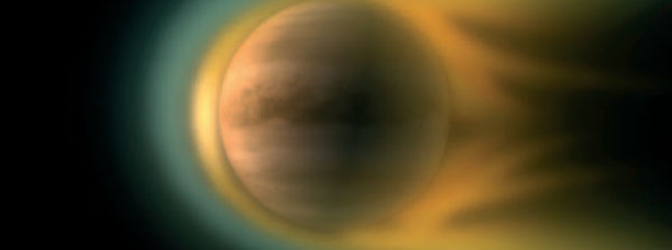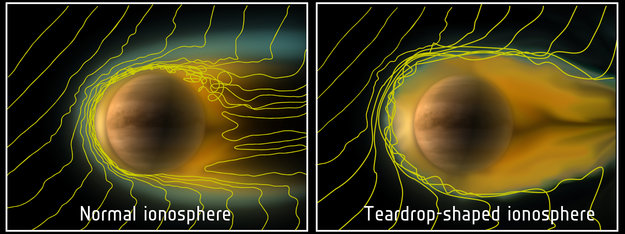Venus Express reveals new facts about Venus’ ionosphere

On January 29, 2013, ESA revealed observations made by the spacecraft in August 2010, when it studied the effect of reduced solar wind on planet's ionosphere. Researchers found that planet’s ionosphere ballooned outward on the planet’s ‘downwind’ nightside, much like the shape of the ion tail seen streaming from a comet under similar conditions.
This is said to have happened because of Venus' weak internal magnetic field, which has partial control over the shape and density of planet's ionosphere. Yong Wei of the Max Planck Institute for Solar System Research in Germany, lead author of the new findings said:
"The teardrop-shaped ionosphere began forming within 30–60 minutes after the normal high pressure solar wind diminished. Over two Earth days, it had stretched to at least two Venus radii into space."
The ionosphere is a region of weakly electrically charged gas high above the main body of a planet’s atmosphere. It is where auroras take place and is responsible for absorbing the most energetic photons from the Sun. It reflects the radio waves, thereby making long-distance radio communication possible. Its shape and density are partly controlled by the internal magnetic field of the planet. As Earth has a strong magnetic field, its ionosphere is relatively stable under a range of solar wind conditions. Whereas, Venus doesn't have its own internal magnetic field and relies instead on interactions with the solar wind to shape its ionosphere.

The change in the ionosphere of Venus during normal solar wind conditions (left) and reduced solar wind activity (right), as observed by ESA’s Venus Express spacecraft in August 2010. The yellow lines show a projection of the solar magnetic field lines as they interact with the ionosphere. (Source: ESA/Wei et al)
So far, there were no observations as to how transportation of ionospheric plasma from the dayside to the night side of Venus is impacted by variation in solar wind's strength. Usually, this material flows along a thin channel in the ionosphere, but scientists were unsure what happens under low solar wind conditions. These observations established that the flow of plasma particles increases as the channel widens due to the reduced confining pressure, thereby proving that the ionosphere expands significantly during low solar wind density conditions. Håkan Svedhem, ESA’s Venus Express project scientist said:
"We often talk about the effects of solar wind interaction with planetary atmospheres during periods of intense solar activity, but Venus Express has shown us that even when there is a reduced solar wind, the Sun can still significantly influence the environment of our planetary neighbours"
At the time of these observations, NASA's Stereo-B spacecraft had measured a drop in solar wind density to 0.1 particles per cubic centimeter – around 50 times lower than the normal and it persisted for about 18 hours. Mars's ionosphere may have a similar impact of reduced solar wind pressure, provided it is the other non-magnetised planet in our inner Solar System.
Source: ESA
Featured image: ESA/Wei et al. (2012)

Commenting rules and guidelines
We value the thoughts and opinions of our readers and welcome healthy discussions on our website. In order to maintain a respectful and positive community, we ask that all commenters follow these rules.